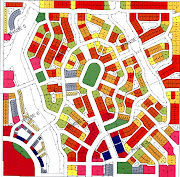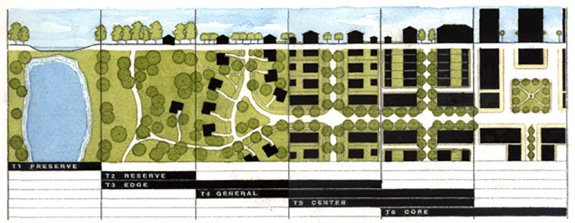To refresh this blog, click here:
http://www.newherbanism.blogspot.com/What’s Behind the Naming of the New Traditional Neighborhood on State Street? The United States of America, in a series of Bounty Land Acts dating from the Revolutionary War in 1776 through 1855, followed a policy of rewarding those who served the country with bounty land grants. Eligibility was gradually extended to include officers and soldiers of the regular army, navy, militia and Native Americans mustered into the service of the United States in time of war.
By the middle of the nineteenth century, Congress had authorized the transfer of sixty million acres of the public domain to veterans as a way for the government to induce men to enlist, to further compensate those who had served, to provide for their widows and children and to settle the west. The land bounty was granted in the form of a warrant. The warrant did not actually convey title to the land, but with his bounty land warrant the veteran could apply for a land patent whereby actual title to the land was transferred to him from the public domain. Most who received a land bounty warrant did not actually take title to any land. Rather, through a wide spread business involving agents, the land bounty warrants were sold to others who redeemed them for the actual land. And so it was that William Scripter, having served in Captain Beach's company of the New York State Militia in the War of 1812, received land bounty Warrant 25,027 and subsequently sold it.
The original patent for the land which will become Omaha area’s first new traditional neighborhood proclaims:
“In pursuance to the Act of Congress, approved March 3, 1855, entitled ‘An Act in addition to certain Acts granting Bounty Land to certain Officers and Soldiers who have been engaged in the military service of the United States’ there has been deposited in the General Land Office, Warrant No. 25,027 . . . .”
Warrant No. 25,027 was redeemed for a patent that, on the first day of October in 1860, the 15th President of the United States of America, James Buchanan, caused to be issued.
The patent land had been owned by the federal government since it was acquired in the Louisiana Purchase of 1803. Before that the French had laid claim to the land which the Omaha Tribe of Native Americans had lived upon for centuries without any concept of private ownership of the land. The Omaha arrived here after having come “up stream,” the literal meaning of “Omaha.” John Lee Webster, President of the Nebraska State Historical Society, noted in his annual address of January 16, 1913:
There is a well authenticated tradition among the Omaha Tribe, that, impelled by a spirit of migration . . . , they took up their journey from their eastern home near the headwaters of the Ohio and followed that river to the union of its waters with the Mississippi, and thence up the eastern side of the Missouri, and eventually permanently settled three and a half centuries ago in what afterward became known as the Nebraska region.
The same spirit that drives all human migration and which impelled the Omaha to come up stream to Nebraska also prompted a certain Englishman in 1855 to sail to America, and then to find his way to Nebraska Territory to settle in Omaha in 1856, and then in 1860 to obtain Warrant 25,027 and to redeem that warrant for a patent from the federal government for 160 acres of virgin prairie in Douglas County, Nebraska Territory. His name was Richard Leytham and he was a farmer. Here is his story and that of his family.
The Nebraska Territorial Census reveals that in 1860 Richard was 37 years old. His wife, Elizabeth, was 31. The Leythams were both born in Lancashire, England. Their eleven year old son, John, and eight year old Thomas were born in Liverpool. Two year old Eleanor was born in Nebraska. Five years later the Leytham family moved to Shelby County, Iowa.
Some twenty-nine years after he received the patent on the 160 acres in Nebraska, the 1889 Biographical History of Shelby County, Iowa records that:
RICHARD LEYTHAM is one of the oldest pioneers of Cass Township, having come there in 1865. He was born in Lancashire, England, March 3, 1823, and is the son of John and Eleanor (Singleton) Leytham. He was reared to the occupation of a farmer. November 12, 1848, he was married to Elizabeth Taylor, a native of England, and a daughter of James and Eunice (Oibin) Taylor. In 1855 Mr. and Mrs. Leytham sailed from Liverpool to America; they landed at Boston and proceeded to Canada, but remained there only a short time comparatively. In the spring of 1856 they removed to Omaha, Nebraska. Omaha then had a few shanties, one hotel, the Douglas House, a small boarding-house called Little Ireland, and lots of whisky. A three days' residence in Omaha satisfied Mr. Leytham and his wife, so they went to Florence, Nebraska, six miles north of Omaha, where they were among the first settlers. They built them a home, and remained there nine years. In 1865 they came to Shelby County, and Mr. Leytham bought sixty acres of land, ten of which were broken; there was a log-cabin on the place, and there was no other between Cass Township and Harlan. Mr. Leytham now owns 220 acres of well-improved land, stocked with a large number of cattle and horses. Mr. and Mrs. Leytham are the parents of fifteen children, nine of whom are living -- John, Thomas, Eleanor, Robert, Richard, Ann Jane, Sarah, Eunice and William; those deceased are -- Eunice, the first child so called, Elizabeth, James, Maggie, Samuel and Charles. The parents are members and zealous supporters of the Latter-Day Saints church, Mr. Leytham being a teacher in the church. He and his wife were brought up in the Church of England, but changed their views after coming to America, and united with the church of the Latter-Day Saints. In politics Mr. Leytham is inclined to the principles of the Democratic party. He is a good conversationalist, genial in his disposition, and an honored and respected citizen of Cass Township.
Source: 1889 Biographical History of Shelby County, Iowa, pp. 478
The Leythams lived on into an old age in Shelby County, Iowa. Elizabeth died on September 26, 1909 at the age of 80. Richard lived to 88, passing away on April 10, 1911. Mr. and Mrs. Leytham are buried Cass Township Cemetery southeast of Portsmouth, Shelby County, Iowa with several of their children and grand children.
Through a series of eight title transfers, from the original 1860 Leytham patent to the founding of the Omaha area’s first new traditional neighborhood, the land has always remained intact. Each owner has passed on the entire 160 acres. Now, after nearly 150 years of private ownership, it is time for the current owner of the land, Herb Freeman, to found a new and enduring traditional neighborhood so that many may benefit from the respectful improvement and wise use of this land.
The Leythams exemplify the pioneer spirit. They came to the new world from the old and lived on the wild frontier. Through industry and effort and living good lives, they began the transformation of the land. The people who live in this new neighborhood will be the next links in the long chain of those, unknown and known, titled or not, who have occupied and used this land over the centuries. It is only fitting and proper that we name this new community after the family who were the pivot point at that unique hinge in time between the unknown who used the land without title and those who come down known to us in the chain of private title. It is only fitting and proper that we name the new neighborhood after the Leythams.
The etymology of British place names reveals that the meaning of “Leytham” perfectly symbolizes the new neighborhood on State Street. “Ley” is the second most common element in British surnames. It comes from the Old English “leah” and the Middle English “leye” meaning clearing, grassland or meadow. The “(t)-ham” ending is a common Anglo-Saxon suffix meaning a home or homestead, and later a village, manor or estate. How appropriate it is that “Leytham” means, quite literally, “Village in the Meadow?”
So where does the credit go for the naming the new traditional neighborhood on State Street? As you may know, during the design charrette we announced a contest with a $500 prize to the person who submitted the name that was selected. Well, no one submitted the actual name. But a few people contributed significantly to the process. Some said, “Why don’t you check the history of the property and see what that suggests.” A title search revealed Richard Leytham as the first private owner of the land. Some in-depth research uncovered his story. One person suggested looking at the etymology of British place names. That produced the derivation of the Leytham name and confirmed its selection as the name for Omaha’s first greenfield new traditional neighborhood. I guess one could say that the process produced the name. You were part of that process if you submitted a name for consideration because you helped me focus my thinking. Thank you to all those who submitted a name. I appreciate your interest and support very much. Since no one person actually submitted the name, the prize will be donated to Habitat for Humanity where it may do a bit of good to bring quality housing to those who most need it
There is a saying among the new urbanists: "Most developers name their projects after whatever it is that they destroyed by developing the project." Think about the names of many of the Omaha area's conventional subdivisions and you will see what they mean. Not so on State Street. Both in terms of its historic significance and its literal meaning, the perfect name by which we shall call the Omaha area’s first new traditional neighborhood is . . . Leytham.
 Artist's rendering of the view across the wetlands and up a greenway to The Commons at Leytham, the "Village in the Meadow."
Artist's rendering of the view across the wetlands and up a greenway to The Commons at Leytham, the "Village in the Meadow." Original Charrette hand drawing by DeDe Christopher, September 2006. See her web site here:
http://www.christopherillustration.com. Of special interest is this link to DeDe's website displaying the beautiful work she created at the Leytham Charrette:
http//www.christopherillustration.com/charrettes/omaha.html. Many thanks, Dede, for bringing life to Leytham.
Herb
Click here to learn more:
www.WhatsNewOnStateStreet.com







